

Compact Muon Solenoid
LHC, CERN
| CMS-PAS-HIG-24-001 | ||
| Search for HHWW couplings in the VBS production of $ \mathrm{W^{\pm}W^{\pm}H} $, with $ \mathrm{H\rightarrow b\bar{b}} $ decays | ||
| CMS Collaboration | ||
| 27 July 2024 | ||
| Abstract: A search is performed for anomalous HHWW couplings based on the process $ \mathrm{pp\rightarrow W^{\pm}W^{\pm}H+jj} $, using proton-proton collision data collected by the CMS experiment at a center-of-mass energy of $ \sqrt{s}= $ 13 TeV in the LHC Run 2, corresponding to a total integrated luminosity of 138 fb$ ^{-1} $. The search is performed in final states that contain a forward-backward jet pair, two W bosons that decay to same-sign leptons, and a Higgs boson that decays into two bottom quarks. Boosted decision trees are trained to separate the signal from the background. The HHWW coupling modifier $ \kappa_{WW} $ is constrained at 95% confidence level to be in the interval $[-3.3, 5.3]$, consistent with the expected interval of $[-2.4, 4.4]$. | ||
| Links: CDS record (PDF) ; CADI line (restricted) ; | ||
| Figures | |
png pdf |
Figure 1:
Tree-level Feynman diagrams of vector boson scattering multi-boson productions with Higgs boson in the final state, with (a) related to the Higgs self-coupling ($ {\kappa_\lambda} $), and (b) related to the Higgs gauge quartic coupling ($ {\kappa_{VV}} $). |
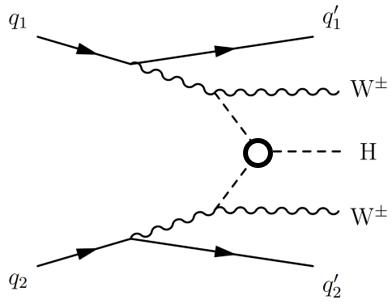
png |
Figure 1-a:
Tree-level Feynman diagrams of vector boson scattering multi-boson productions with Higgs boson in the final state, with (a) related to the Higgs self-coupling ($ {\kappa_\lambda} $), and (b) related to the Higgs gauge quartic coupling ($ {\kappa_{VV}} $). |

png |
Figure 1-b:
Tree-level Feynman diagrams of vector boson scattering multi-boson productions with Higgs boson in the final state, with (a) related to the Higgs self-coupling ($ {\kappa_\lambda} $), and (b) related to the Higgs gauge quartic coupling ($ {\kappa_{VV}} $). |
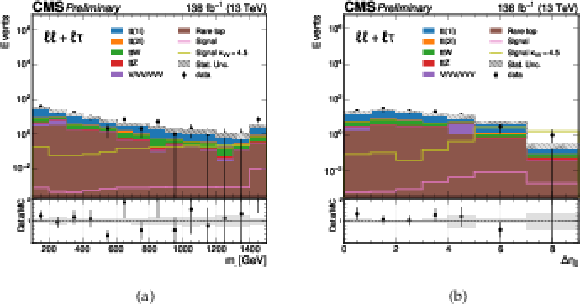
png pdf |
Figure 2:
Data-MC comparison of $ m_{jj} $ and $ \Delta\eta_{jj} $ distributions in the pre-selection regions. Two signal hypotheses, with one for $ {\kappa_{VV}} = $ 1 which represents the SM and the other for $ {\kappa_{VV}} = $ 4.5, are plotted. The uncertainty band in the ratio plots represents the pre-fit statistical uncertainty of the Monte Carlo, which corresponds to the uncertainty band in the distribution plots. |

png pdf |
Figure 2-a:
Data-MC comparison of $ m_{jj} $ and $ \Delta\eta_{jj} $ distributions in the pre-selection regions. Two signal hypotheses, with one for $ {\kappa_{VV}} = $ 1 which represents the SM and the other for $ {\kappa_{VV}} = $ 4.5, are plotted. The uncertainty band in the ratio plots represents the pre-fit statistical uncertainty of the Monte Carlo, which corresponds to the uncertainty band in the distribution plots. |
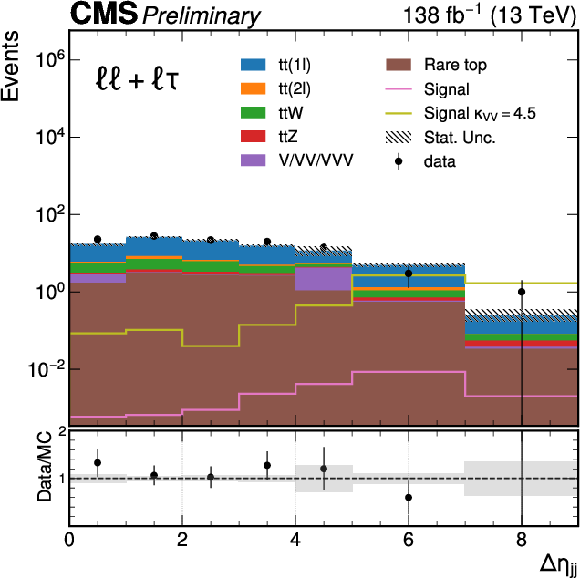
png pdf |
Figure 2-b:
Data-MC comparison of $ m_{jj} $ and $ \Delta\eta_{jj} $ distributions in the pre-selection regions. Two signal hypotheses, with one for $ {\kappa_{VV}} = $ 1 which represents the SM and the other for $ {\kappa_{VV}} = $ 4.5, are plotted. The uncertainty band in the ratio plots represents the pre-fit statistical uncertainty of the Monte Carlo, which corresponds to the uncertainty band in the distribution plots. |
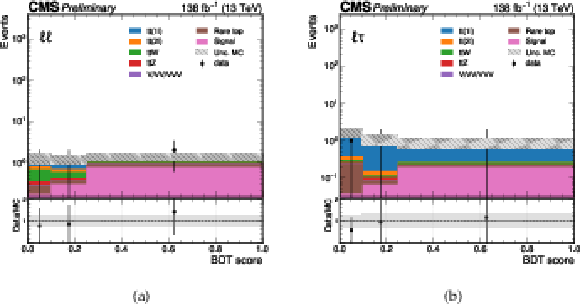
png pdf |
Figure 3:
Post-fit shapes for the SR, including (a) $ \ell\ell $ final state (b) $ \ell\tau $ final state. The uncertainty band in the ratio plots represents the post-fit uncertainty of the Monte Carlo, which corresponds to the uncertainty band in the distribution plots. |

png pdf |
Figure 3-a:
Post-fit shapes for the SR, including (a) $ \ell\ell $ final state (b) $ \ell\tau $ final state. The uncertainty band in the ratio plots represents the post-fit uncertainty of the Monte Carlo, which corresponds to the uncertainty band in the distribution plots. |

png pdf |
Figure 3-b:
Post-fit shapes for the SR, including (a) $ \ell\ell $ final state (b) $ \ell\tau $ final state. The uncertainty band in the ratio plots represents the post-fit uncertainty of the Monte Carlo, which corresponds to the uncertainty band in the distribution plots. |

png pdf |
Figure 4:
Limits of $ \kappa_{VV} $ with CL=95%. |
| Tables | |
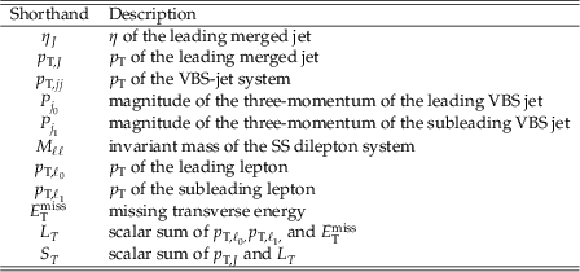
png pdf |
Table 1:
Input variables used for the event kinematics BDT. |
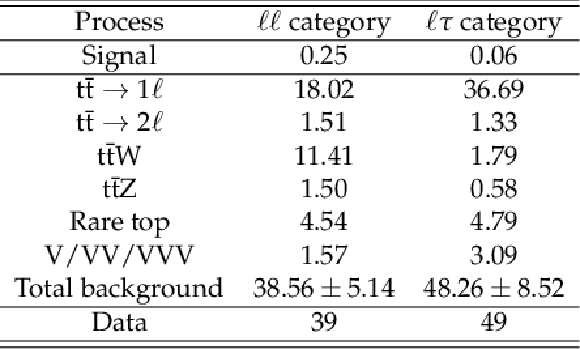
png pdf |
Table 2:
The post-fit yields of the CR, for $ \ell\ell $ and $ \ell\tau $ categories separately. The errors for total background include the statistical and systematic uncertainties. |
| Summary |
| Data recorded with the CMS experiment during LHC Run 2 amounting to 138 $ \mathrm{fb}^{-1} $ of pp collisions at $ \sqrt{s}= $ 13 TeV are used to search for anomalous couplings in the process $ \mathrm{pp} \rightarrow \mathrm{W}^{ \pm} \mathrm{W}^{ \pm} \mathrm{H}+\mathrm{jj} $, where the Higgs boson decays to two bottom quarks and the W bosons decay leptonically. The analysis focuses on the channel in which the two b-jets are merged. The observed(expected) 95% CL interval for $ \kappa_{WW} $ is $[-3.3, 5.3]$($[-2.4, 4.4]$). This marks the first analysis of the $ \mathrm{pp} \rightarrow \mathrm{W}^{ \pm} \mathrm{W}^{ \pm} \mathrm{H}+\mathrm{jj} $ process and opens the possibility of further analysis of the same process with different final states. |
| References | ||||
| 1 | CMS Collaboration | Observation of a new boson at a mass of 125 GeV with the CMS experiment at the LHC | PLB 716 (2012) 30 | |
| 2 | C. Englert et al. | VBS $ W^{\pm}W^{\pm}H $ production at the HL-LHC and a 100 TeV pp-collider | International Journal of Modern Physics A 32 (2017) 1750106 | |
| 3 | CMS Collaboration | Precision luminosity measurement in proton-proton collisions at $ \sqrt{s}= $ 13 TeV in 2015 and 2016 at CMS | EPJC 81 (2021) 800 | CMS-LUM-17-003 2104.01927 |
| 4 | CMS Collaboration | CMS luminosity measurement for the 2017 data-taking period at $ \sqrt{s} = $ 13 TeV | CMS Physics Analysis Summary, 2018 link |
CMS-PAS-LUM-17-004 |
| 5 | CMS Collaboration | CMS luminosity measurement for the 2018 data-taking period at $ \sqrt{s} = $ 13 TeV | CMS Physics Analysis Summary, 2019 link |
CMS-PAS-LUM-18-002 |
| 6 | CMS Collaboration | The CMS experiment at the CERN LHC | JINST 3 (2008) S08004 | |
| 7 | CMS Collaboration | Performance of the CMS Level-1 trigger in proton-proton collisions at $ \sqrt{s} = $ 13 TeV | JINST 15 (2020) P10017 | CMS-TRG-17-001 2006.10165 |
| 8 | CMS Collaboration | The CMS trigger system | JINST 12 (2017) P01020 | |
| 9 | GEANT4 Collaboration | GEANT 4--a simulation toolkit | NIM A 506 (2003) 250 | |
| 10 | J. Alwall et al. | The automated computation of tree-level and next-to-leading order differential cross sections, and their matching to parton shower simulations | JHEP 07 (2014) 079 | 1405.0301 |
| 11 | T. Sjöstrand et al. | An introduction to PYTHIA 8.2 | Comput. Phys. Commun. 191 (2015) 159 | 1410.3012 |
| 12 | NNPDF Collaboration | Parton distributions from high-precision collider data | EPJC 77 (2017) 663 | 1706.00428 |
| 13 | P. Nason | A new method for combining NLO QCD with shower Monte Carlo algorithms | JHEP 11 (2004) 040 | hep-ph/0409146 |
| 14 | S. Frixione, P. Nason, and C. Oleari | Matching NLO QCD computations with parton shower simulations: the POWHEG method | JHEP 11 (2007) 070 | 0709.2092 |
| 15 | S. Alioli, P. Nason, C. Oleari, and E. Re | A general framework for implementing NLO calculations in shower Monte Carlo programs: the POWHEG box | JHEP 06 (2010) 043 | 1002.2581 |
| 16 | A. M. Sirunyan et al. | Particle-flow reconstruction and global event description with the CMS detector | JINST 12 (2017) P10003 | |
| 17 | CMS Collaboration | Electron and photon reconstruction and identification with the CMS experiment at the CERN LHC | JINST 16 (2021) P05014 | CMS-EGM-17-001 2012.06888 |
| 18 | CMS Collaboration | Performance of the CMS muon detector and muon reconstruction with proton-proton collisions at $ \sqrt{s}= $ 13 TeV | JINST 13 (2018) P06015 | CMS-MUO-16-001 1804.04528 |
| 19 | CMS Collaboration | Performance of reconstruction and identification of $ \tau $ leptons decaying to hadrons and $ \nu_\tau $ in pp collisions at $ \sqrt{s}= $ 13 TeV | JINST 13 (2018) P10005 | CMS-TAU-16-003 1809.02816 |
| 20 | CMS Collaboration | Identification of hadronic tau lepton decays using a deep neural network | JINST 17 (2022) P07023 | CMS-TAU-20-001 2201.08458 |
| 21 | M. Cacciari, G. P. Salam, and G. Soyez | FastJet user manual | EPJC 72 (2012) 1896 | 1111.6097 |
| 22 | M. Cacciari, G. P. Salam, and G. Soyez | The anti-$ k_t $ jet clustering algorithm | JHEP 04 (2008) 063 | 0802.1189 |
| 23 | E. Bols et al. | Jet flavour classification using DeepJet | JINST 15 (2020) P12012 | 2008.10519 |
| 24 | CMS Collaboration | Performance summary of AK4 jet b tagging with data from proton-proton collisions at 13 TeV with the CMS detector | CMS Detector Performance Note CMS-DP-2023-005, 2023 CDS |
|
| 25 | A. J. Larkoski, S. Marzani, G. Soyez, and J. Thaler | Soft drop | JHEP 05 (2014) 146 | 1402.2657 |
| 26 | H. Qu and L. Gouskos | Jet tagging via particle clouds | PRD 101 (2020) 056019 | |
| 27 | T. Chen and C. Guestrin | XGBoost: A scalable tree boosting system | in Proc. 22nd ACM SIGKDD Int. Conf. on Knowledge Discovery and Data Mining, KDD '16, New York, 2016 link |
|
| 28 | CMS Collaboration | The CMS statistical analysis and combination tool: Combine | Accepted by Comput. Softw. Big Sci, 2024 | CMS-CAT-23-001 2404.06614 |
| 29 | CMS Collaboration | Study of WH production through vector boson scattering and extraction of the relative sign of the W and Z couplings to the Higgs boson in proton-proton collisions at $ \sqrt{s} = $ 13 TeV | Submitted to Phys. Lett. B | CMS-HIG-23-007 2405.16566 |
| 30 | D. de Florian et al. | Handbook of LHC Higgs Cross Sections: 4. Deciphering the Nature of the Higgs Sector | CYRM-2017-002 (CERN), 2017 link |
1610.07922 |
| 31 | R. J. Barlow and C. Beeston | Fitting using finite Monte Carlo samples | Comput. Phys. Commun. 77 (1993) 219 | |

|
Compact Muon Solenoid LHC, CERN |

|

|

|

|

|

|